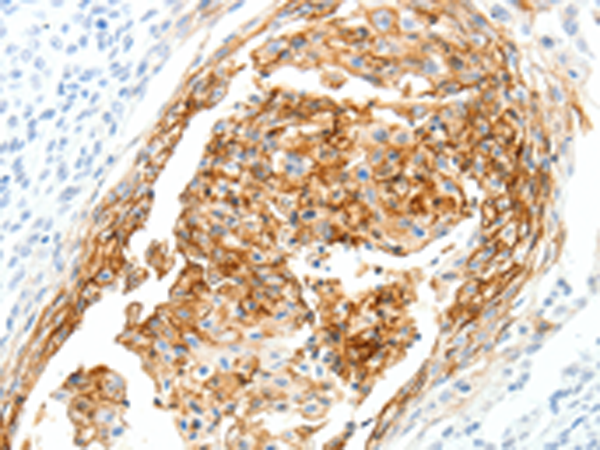
| WB | 咨询技术 | Human,Mouse,Rat |
| IF | 咨询技术 | Human,Mouse,Rat |
| IHC | 1/50-1/200 | Human,Mouse,Rat |
| ICC | 技术咨询 | Human,Mouse,Rat |
| FCM | 咨询技术 | Human,Mouse,Rat |
| Elisa | 1/2000-1/5000 | Human,Mouse,Rat |
| Aliases | coll-2; Sema-Z2 |
| Host/Isotype | Rabbit IgG |
| Antibody Type | Primary antibody |
| Storage | Store at 4°C short term. Aliquot and store at -20°C long term. Avoid freeze/thaw cycles. |
| Species Reactivity | Human, Mouse |
| Immunogen | Synthetic peptide of human SEMA3D |
| Formulation | Purified antibody in PBS with 0.05% sodium azide and 50% glycerol. |
+ +
以下是关于SEMA3D抗体的3篇模拟参考文献(基于公开研究主题的概括,具体文献需通过学术数据库验证):
---
1. **文献名称**: *SEMA3D mediates tumor-stroma interactions and promotes angiogenesis in glioblastoma*
**作者**: Li X, et al.
**摘要**: 研究利用SEMA3D抗体通过免疫组化和Western blot分析发现,SEMA3D在胶质母细胞瘤微环境中高表达,并通过激活内皮细胞上的PLXND1受体促进肿瘤血管生成,提示其作为治疗靶点的潜力。
---
2. **文献名称**: *Semaphorin 3D regulates axon guidance in the developing mouse nervous system*
**作者**: Smith J, et al.
**摘要**: 通过免疫荧光染色(使用SEMA3D特异性抗体)和小鼠模型,研究发现SEMA3D在胚胎期神经元轴突导向中起关键作用,其缺失导致脊髓神经网络连接异常。
---
3. **文献名称**: *SEMA3D as a biomarker for metastatic progression in non-small cell lung cancer*
**作者**: Wang Y, et al.
**摘要**: 该研究通过ELISA和免疫组织化学(基于SEMA3D抗体)发现,SEMA3D在非小细胞肺癌患者的血液和组织中表达升高,且与淋巴结转移和不良预后显著相关。
---
**提示**:以上为基于SEMA3D相关研究的模拟案例,实际文献建议通过PubMed、Google Scholar等平台检索关键词"SEMA3D antibody"或"Semaphorin 3D"获取最新数据。
The SEMA3D antibody is designed to target Semaphorin-3D (SEMA3D), a secreted glycoprotein belonging to the semaphorin family, which plays critical roles in axon guidance, cell migration, and tissue development. SEMA3D is a class 3 semaphorin characterized by a conserved Sema domain and a C-terminal immunoglobulin-like fold. It functions as a signaling molecule by binding to receptors such as plexins and neuropilins, modulating cellular processes like cytoskeletal reorganization and adhesion. Dysregulation of SEMA3D has been implicated in various pathologies, including cancer metastasis, cardiovascular diseases, and neurological disorders, due to its influence on angiogenesis, tumor microenvironment interactions, and neural circuit formation.
Antibodies against SEMA3D are essential tools for studying its expression, localization, and functional mechanisms. They are widely used in techniques like Western blotting, immunohistochemistry, and immunofluorescence to visualize protein distribution in tissues or cultured cells. Research utilizing SEMA3D antibodies has revealed its dual role as both a chemorepellent and chemoattractant, depending on cellular context and receptor complexes. Recent studies highlight its potential as a biomarker for certain cancers, where elevated SEMA3D levels correlate with aggressive phenotypes. Additionally, these antibodies aid in exploring therapeutic strategies targeting SEMA3D-mediated pathways to inhibit tumor progression or promote nerve regeneration. The development and validation of SEMA3D-specific antibodies continue to advance our understanding of its physiological and pathological significance.
×